Page 132 of 228

132
Driving and operating
Selector lever P
=Park position. Front wheels
locked. Engage only when the
vehicle is stationary and the
hand brake is applied.
R = Reverse gear. Engage only
when vehicle is stationary.
N = Neutral.
D = Automatic mode with all gears. The selector lever can only be moved
out of P or N
when the ignition is on
and the foot brake is depressed
(Selector lever lock).
When the selector lever is in N, the
selector lever lock is activated after
a delay and only if the vehicle is
stationary. When the selector lever is in the P or
N position, control indicator j in the
gear indicator strip illuminates red
when the selector lever is locked. If
the selector lever is not in the P
position
when the ignition is switched
off, control indicator j and P in the
gear indicator strip flash.
To engage P or R, push button on
selector lever.
The engine can only be started with
lever in position P or N. When position
N is selected, press foot brake or
engage hand brake before starting.
Page 133 of 228
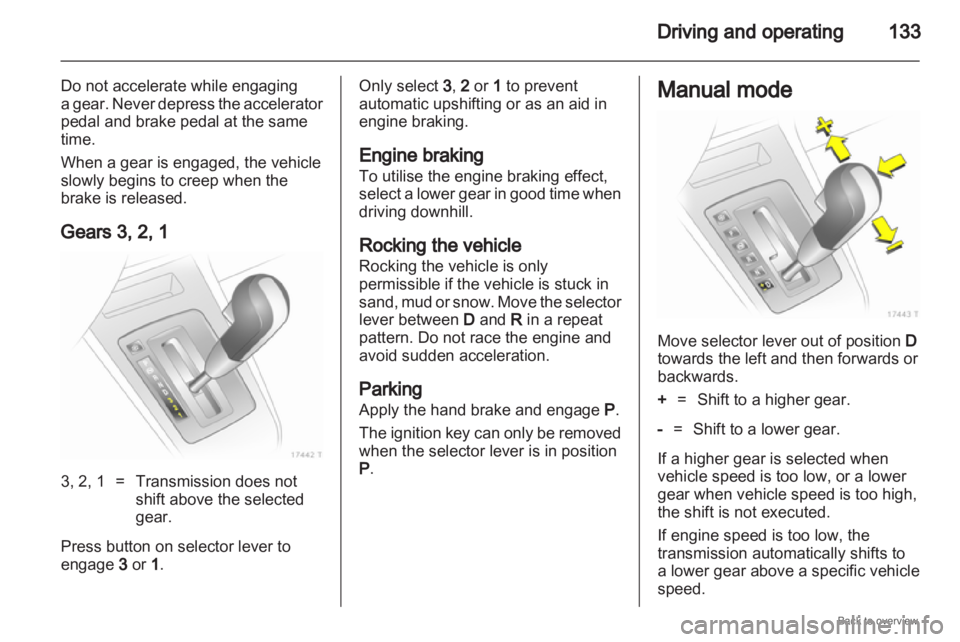
Driving and operating
133
Do not accelerate while engaging
a gear. Never depress the accelerator
pedal and brake pedal at the same
time.
When a gear is engaged, the vehicle
slowly begins to creep when the
brake is released.
Gears 3, 2, 1 3, 2, 1 = Transmission does not
shift above the selected
gear.
Press button on selector lever to
engage 3 or 1 . Only select 3
, 2 or 1 to prevent
automatic upshifting or as an aid in
engine braking.
Engine braking
To utilise the engine braking effect,
select
a lower gear in good time when
driving downhill.
Rocking the vehicle
Rocking the vehicle is only
permissible if the vehicle is stuck in
sand, mud or snow. Move the selector
lever between D and R in a repeat
pattern. Do not race the engine and
avoid sudden acceleration.
Parking
Apply the hand brake and engage P.
The ignition key can only be removed
when the selector lever is in position
P. Manual mode
Move selector lever out of position
D
towards the left and then forwards or
backwards.
+ = Shift to a higher gear.
- = Shift to a lower gear.
If a higher gear is selected when
vehicle speed is too low, or a lower
gear when vehicle speed is too high,
the shift is not executed.
If engine speed is too low, the
transmission automatically shifts to
a lower gear above a specific vehicle
speed.
Page 135 of 228
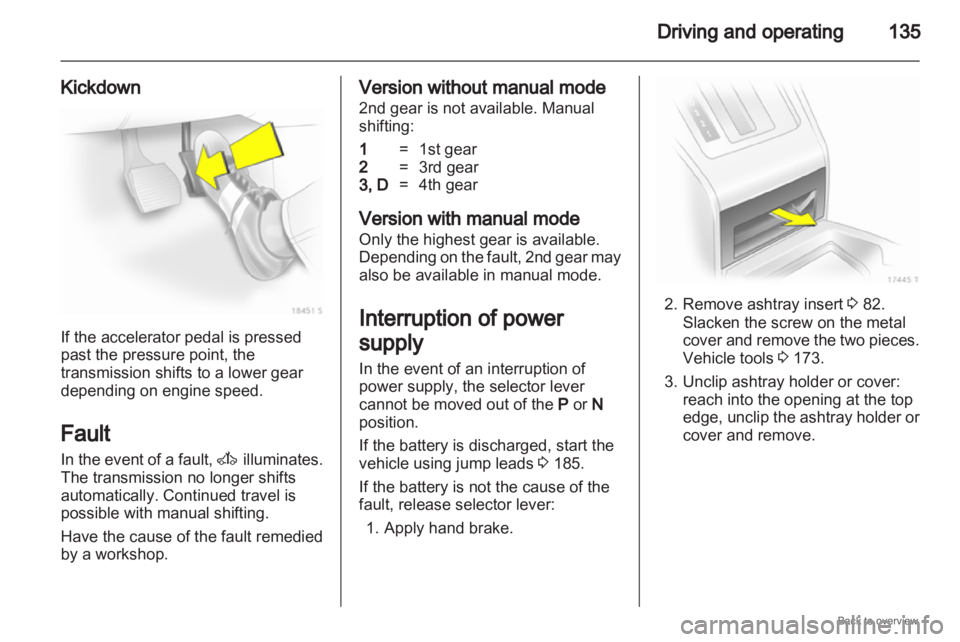
Driving and operating
135
Kickdown If the accelerator pedal is pressed
past the pressure point, the
transmission shifts to a lower gear
depending on engine speed.
Fault
In
the event of a fault, A illuminates.
The transmission no longer shifts
automatically. Continued travel is
possible with manual shifting.
Have the cause of the fault remedied
by a workshop. Version without manual mode
2nd gear is not available. Manual
shifting:
1
= 1st gear
2 = 3rd gear
3, D =4th gear
Version with manual mode
Only the highest gear is available.
Depending
on the fault, 2nd gear may
also be available in manual mode.
Interruption of power
supply
In the event of an interruption of
power supply, the selector lever
cannot be moved out of the P or N
position.
If the battery is discharged, start the
vehicle using jump leads 3 185.
If the battery is not the cause of the
fault, release selector lever: 1. Apply hand brake. 2. Remove ashtray insert
3 82.
Slacken the screw on the metal
cover
and remove the two pieces.
Vehicle tools 3 173.
3. Unclip ashtray holder or cover: reach into the opening at the top
edge, unclip the ashtray holder or
cover and remove.
Page 136 of 228
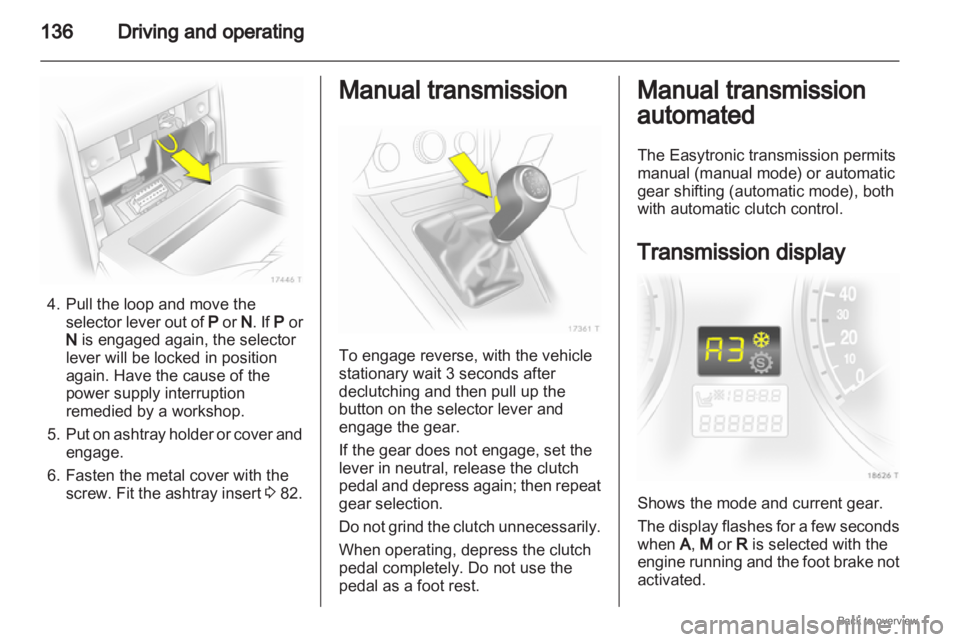
136
Driving and operating4. Pull the loop and move the
selector lever out of P or N. If P or
N is engaged again, the selector
lever will be locked in position
again. Have the cause of the
power supply interruption
remedied by a workshop.
5. Put on ashtray holder or cover and engage.
6. Fasten the metal cover with the screw. Fit the ashtray insert 3 82. Manual transmission
To engage reverse, with the vehicle
stationary wait 3 seconds after
declutching and then pull up the
button on the selector lever and
engage the gear.
If the gear does not engage, set the
lever in neutral, release the clutch
pedal
and depress again; then repeat
gear selection.
Do not grind the clutch unnecessarily.
When operating, depress the clutch
pedal completely. Do not use the
pedal as a foot rest. Manual transmission
automated
The Easytronic transmission permits
manual (manual mode) or automatic
gear shifting (automatic mode), both
with automatic clutch control.
Transmission display
Shows the mode and current gear.
The
display flashes for a few seconds
when A, M or R is selected with the
engine running and the foot brake not
activated.
Page 137 of 228
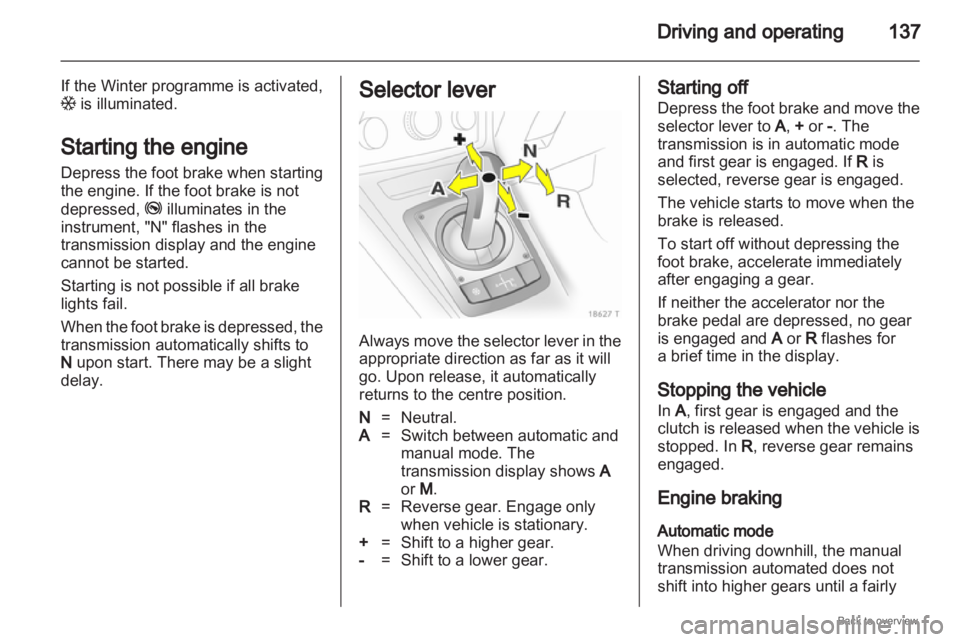
Driving and operating
137
If the Winter programme is activated,
T is illuminated.
Starting the engine
Depress the foot brake when starting
the engine. If the foot brake is not
depressed, j illuminates in the
instrument, "N" flashes in the
transmission display and the engine
cannot be started.
Starting is not possible if all brake
lights fail.
When
the foot brake is depressed, the
transmission automatically shifts to
N upon start. There may be a slight
delay. Selector lever
Always move the selector lever in the
appropriate direction as far as it will
go. Upon release, it automatically
returns to the centre position.
N
= Neutral.
A = Switch between automatic and
manual mode. The
transmission display shows A
or M.
R = Reverse gear. Engage only
when vehicle is stationary.
+ = Shift to a higher gear.
- = Shift to a lower gear. Starting off
Depress
the foot brake and move the
selector lever to A, + or -. The
transmission is in automatic mode
and first gear is engaged. If R is
selected, reverse gear is engaged.
The vehicle starts to move when the
brake is released.
To start off without depressing the
foot brake, accelerate immediately
after engaging a gear.
If neither the accelerator nor the
brake pedal are depressed, no gear
is engaged and A or R flashes for
a brief time in the display.
Stopping the vehicle
In A, first gear is engaged and the
clutch is released when the vehicle is
stopped. In R , reverse gear remains
engaged.
Engine braking
Automatic mode
When driving downhill, the manual
transmission automated does not
shift into higher gears until a fairly
Page 138 of 228
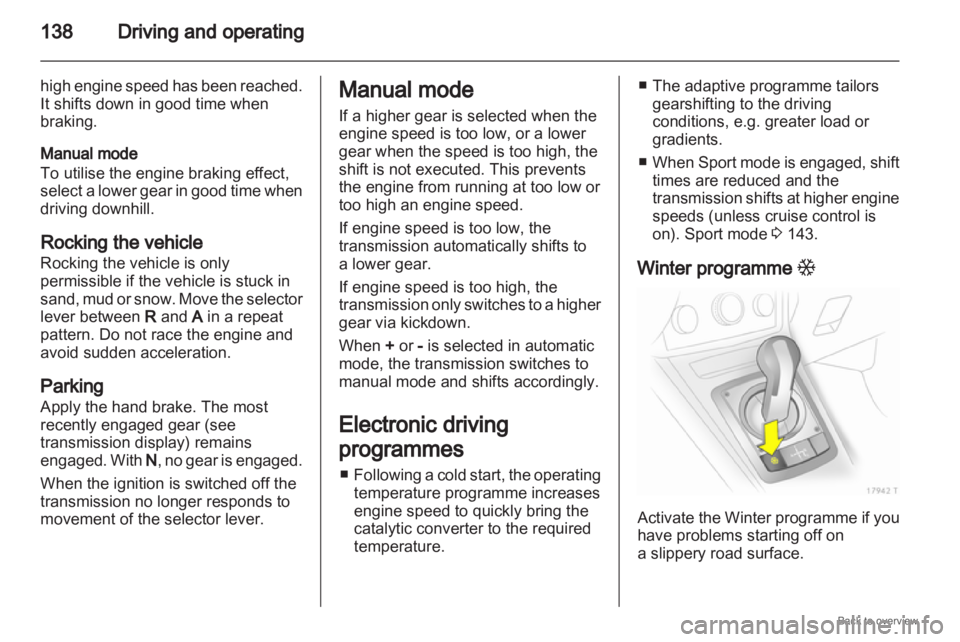
138
Driving and operating
high engine speed has been reached.
It shifts down in good time when
braking.
Manual mode
To utilise the engine braking effect,
select
a lower gear in good time when
driving downhill.
Rocking the vehicle
Rocking the vehicle is only
permissible if the vehicle is stuck in
sand, mud or snow. Move the selector
lever between R and A in a repeat
pattern. Do not race the engine and
avoid sudden acceleration.
Parking
Apply the hand brake. The most
recently engaged gear (see
transmission display) remains
engaged. With N, no gear is engaged.
When the ignition is switched off the
transmission no longer responds to
movement of the selector lever. Manual mode
If a higher gear is selected when the
engine speed is too low, or a lower
gear when the speed is too high, the
shift is not executed. This prevents
the engine from running at too low or
too high an engine speed.
If engine speed is too low, the
transmission automatically shifts to
a lower gear.
If engine speed is too high, the
transmission
only switches to a higher
gear via kickdown.
When + or - is selected in automatic
mode, the transmission switches to
manual mode and shifts accordingly.
Electronic driving
programmes
■ Following a cold start, the operating
temperature programme increases
engine speed to quickly bring the
catalytic converter to the required
temperature. ■ The adaptive programme tailors
gearshifting to the driving
conditions, e.g. greater load or
gradients.
■ When Sport
mode is engaged, shift
times are reduced and the
transmission shifts at higher engine
speeds (unless cruise control is
on). Sport mode 3 143.
Winter programme T Activate the Winter programme if you
have problems starting off on
a slippery road surface.
Page 140 of 228

140
Driving and operatingIf the vehicle must be moved out of
the flow of traffic, disengage the
clutch as follows:
1.
Apply hand brake and switch offignition.
2. Open the bonnet 3 155.
3. Clean the transmission around the cap so that no dirt can get into
the opening when the cap is
removed.
4. Rotate cap to slacken and remove by lifting upwards. 5. Using a flat-head screwdriver,
turn
the adjusting screw under the
cap clockwise until clear
resistance can be felt. The clutch
has now been disengaged.
6. Refit cleaned cap. The cap must be in full contact with the housing. Caution
Do not turn beyond the resistance
since this could damage the
transmission.
Caution
Towing the vehicle and starting
the engine is not permitted when
the
clutch has been disengaged in
this way, although the vehicle can
be moved a short distance. Seek the immediate assistance of
a workshop. Brakes
The brake system comprises two
independent brake circuits.
If a brake circuit fails, the vehicle can
still be braked using the other brake
circuit. However, braking effect is
achieved only when you depress the
brake pedal firmly. You need to use
considerably more force for this. The
braking distance is extended. Seek
the assistance of a workshop before
continuing your journey.
When the engine is not running, the
support of the brake servo unit
disappears
once the brake pedal has
been depressed once or twice.
Braking effect is not reduced, but
braking requires significantly greater
force. It is especially important to bear
this in mind when being towed.
Control indicator R 3 89.
Antilock brake system
Antilock brake system (ABS)
prevents the wheels from locking.
Page 141 of 228
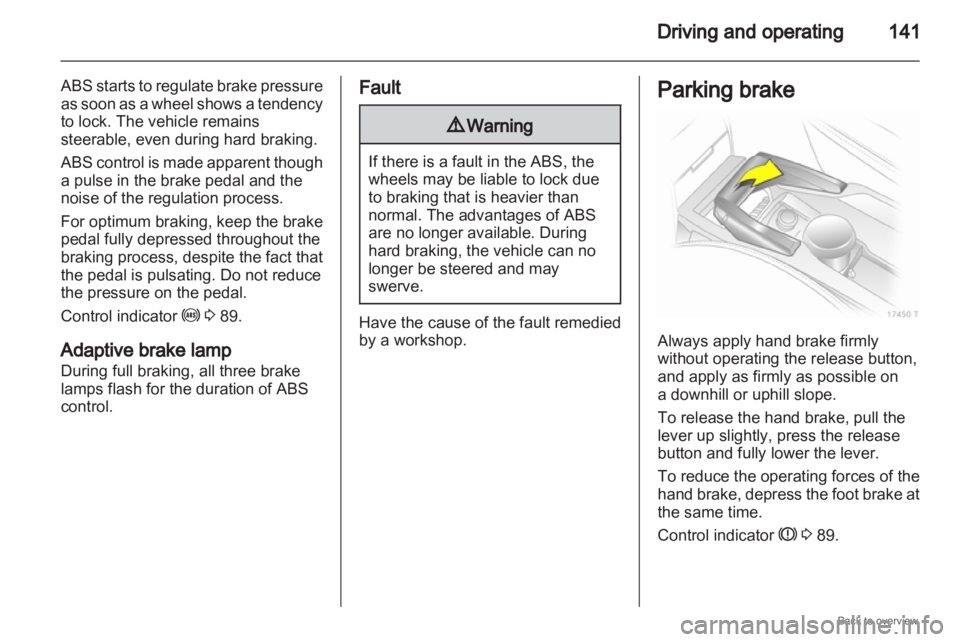
Driving and operating
141
ABS starts to regulate brake pressure
as soon as a wheel shows a tendency
to lock. The vehicle remains
steerable, even during hard braking.
ABS control is made apparent though
a pulse in the brake pedal and the
noise of the regulation process.
For optimum braking, keep the brake
pedal fully depressed throughout the
braking process, despite the fact that
the pedal is pulsating. Do not reduce
the pressure on the pedal.
Control indicator u 3 89.
Adaptive brake lamp
During full braking, all three brake
lamps flash for the duration of ABS
control. Fault
9
Warning If there is a fault in the ABS, the
wheels may be liable to lock due
to braking that is heavier than
normal. The advantages of ABS
are no longer available. During
hard braking, the vehicle can no
longer be steered and may
swerve.
Have the cause of the fault remedied
by a workshop. Parking brake
Always apply hand brake firmly
without operating the release button,
and apply as firmly as possible on
a downhill or uphill slope.
To release the hand brake, pull the
lever up slightly, press the release
button and fully lower the lever.
To
reduce the operating forces of the
hand brake, depress the foot brake at
the same time.
Control indicator R 3 89.